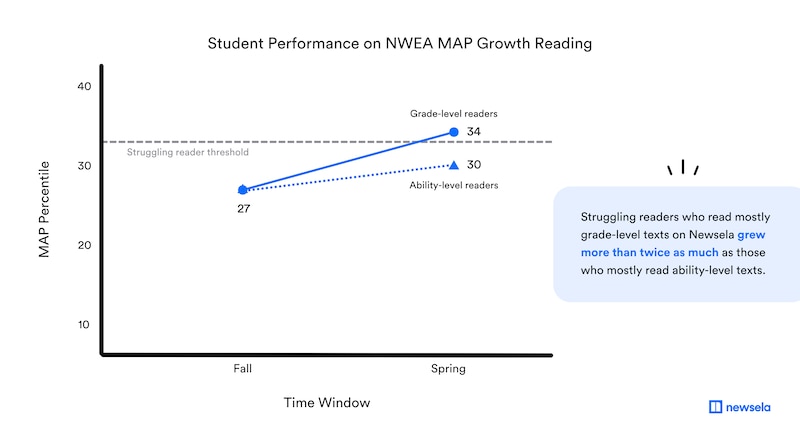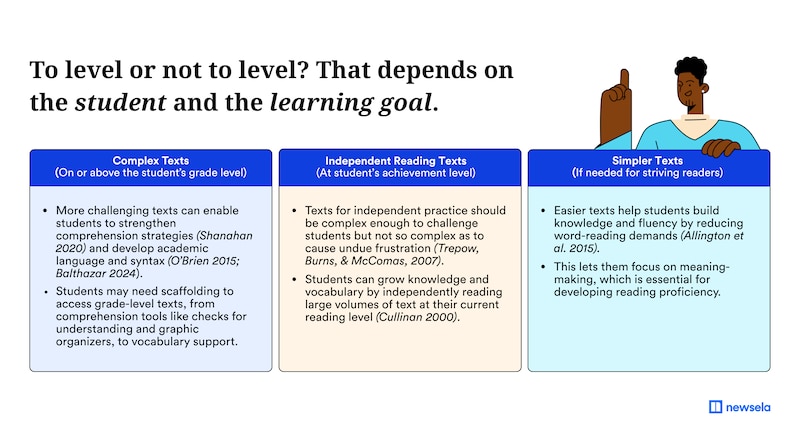Many leaders and experts argue that students should be given grade-level texts to support reading growth. Results from research indicate a more nuanced conversation about grade-level instruction and text leveling is warranted.
The reigning approach is that much of students’ reading time in classrooms should be spent in grade-level texts, read with scaffolding and support from teachers. This approach provides students with the best opportunity to meet grade-level expectations for reading skill and content knowledge. On the other hand, some argue that giving readers simpler texts can help reduce frustration and allow students to practice reading strategies independently, learn content from the texts they read, and develop reading motivation and engagement.
In a series of studies, the Newsela research team examined whether giving grade-level texts to struggling readers could positively impact their learning outcomes.
First, Newsela researchers identified a group of struggling middle school readers based on their fall scores on the NWEA MAP Growth Reading test. All of the students started the school year reading at the 33rd percentile or below and used Newsela at least once a month over the entire school year. Next, the researchers divided these students into two groups based on the level of the Newsela articles they read over the school year. These groups were matched on fall ELA achievement, grade, and overall amount of Newsela usage.
- Grade-level readers (n = 789) tended to read articles on Newsela that matched their grade level.
- Ability-level readers (n = 789) tended to read articles on Newsela that matched their ability level (i.e., students struggling to read grade-level texts).
The researchers then looked at how these two groups performed on their ELA assessment in the spring.

Struggling readers who read mostly grade-level texts on Newsela grew more than twice as much as those who mostly read ability-level texts.
In a second study to better understand why the grade-level group showed better ELA outcomes, researchers spoke to “grade-level” middle school teachers (who assigned mostly grade-level texts on Newsela) and “ability-level” middle school teachers (who assigned mostly ability-level texts) from four states. All of these educators were dedicated teachers who selected high-interest, relevant texts as part of their curriculum to keep students engaged and foster broad growth.
Researchers found that it takes more than simply assigning grade-level texts to support reading growth. Five key factors distinguished the grade-level teachers from the ability-level teachers:
- Concrete and ambitious learning goals. Grade-level teachers held high standards for their students and took responsibility for students achieving concrete proficiency targets.
- Regular progress monitoring. Grade-level teachers used progress monitoring to gauge how students were tracking towards these goals, and adjusted instruction based on data.
- Purposeful, explicit instructional time. Grade-level teachers engaged in minimal “busy work.” Instead, they carefully curated every (or nearly every) learning experience to have clear objectives supporting learning, engagement, or both.
- Purposeful text selection. Grade-level teachers aligned texts with performance goals and balanced out the rest of the curriculum. Just as these teachers were purposeful when selecting activities, they also were intentional with their choice of texts.
- Community collaboration. The grade-level teachers shared tips and tricks with their peers. A few also described school-wide initiatives to foster reading growth.
Taken together, these two studies suggest that while text leveling is related to student growth, it is not just simple exposure to challenging texts that drives this growth. Instead, it is the teachers who use these texts to challenge their students strategically to build towards ambitious achievement goals that drive the most growth. The most appropriate level of text can change based on a teacher’s current learning goal for their students, which makes the conversation about whether or not to level text more nuanced.

Examples of appropriate text complexities for different classroom scenarios
Scenario 1: Whole-class or small-group instruction
In a whole-class or small-group setting, teaching more complex reading skills and building comprehension is often the goal. In these situations, the research suggests that providing students with grade-level or higher texts allows them to better expand their comprehension skills, learn new strategies, and build skills and stamina.
Scenario 2: Independent reading
In some cases, teachers may allow students to pick texts that interest them for independent reading. Leveled texts are great in this scenario. Texts that match students’ current reading abilities and can be read accurately and independently give extra fluency practice and facilitate general knowledge acquisition, self-efficacy, and engagement.
While reading at a lower or independent level (if needed) can help support fluency, comprehension, motivation, and learning from text, students need exposure to complex vocabulary, language, and content that contribute to the development of more sophisticated reading comprehension skills and mastery of grade-level reading standards.
Based on the above findings, educators should strive to support their struggling readers with a variety of opportunities for reading practice and explicit instruction, with scaffolding to support more challenging texts. Data-driven instruction, done well, aligns concrete learning goals with purposeful text selection, instructional time, and collaboration.
Newsela’s products for ELA, Social Studies, and STEM contain complex and simpler texts and can be used for independent, small group, or whole class reading scenarios. The products provide five levels of text complexity for all nonfiction content so teachers can use appropriately leveled texts based on the needs of their students and their instructional goals. Teachers can also choose to select and lock the text level for each student to increase the level of challenge for teacher-led instruction with grade-level texts. Newsela’s texts also provide scaffolds like Guided Highlighting, Checks for Understanding, Annotations, Listen Mode, and Text Translator tools that enable teachers to easily personalize lessons for individual student needs.
Chalkbeat’s editorial staff had no role in writing or preparing this paid content. Learn about our sponsored content policy.


